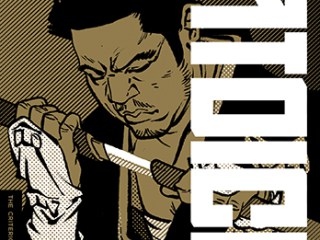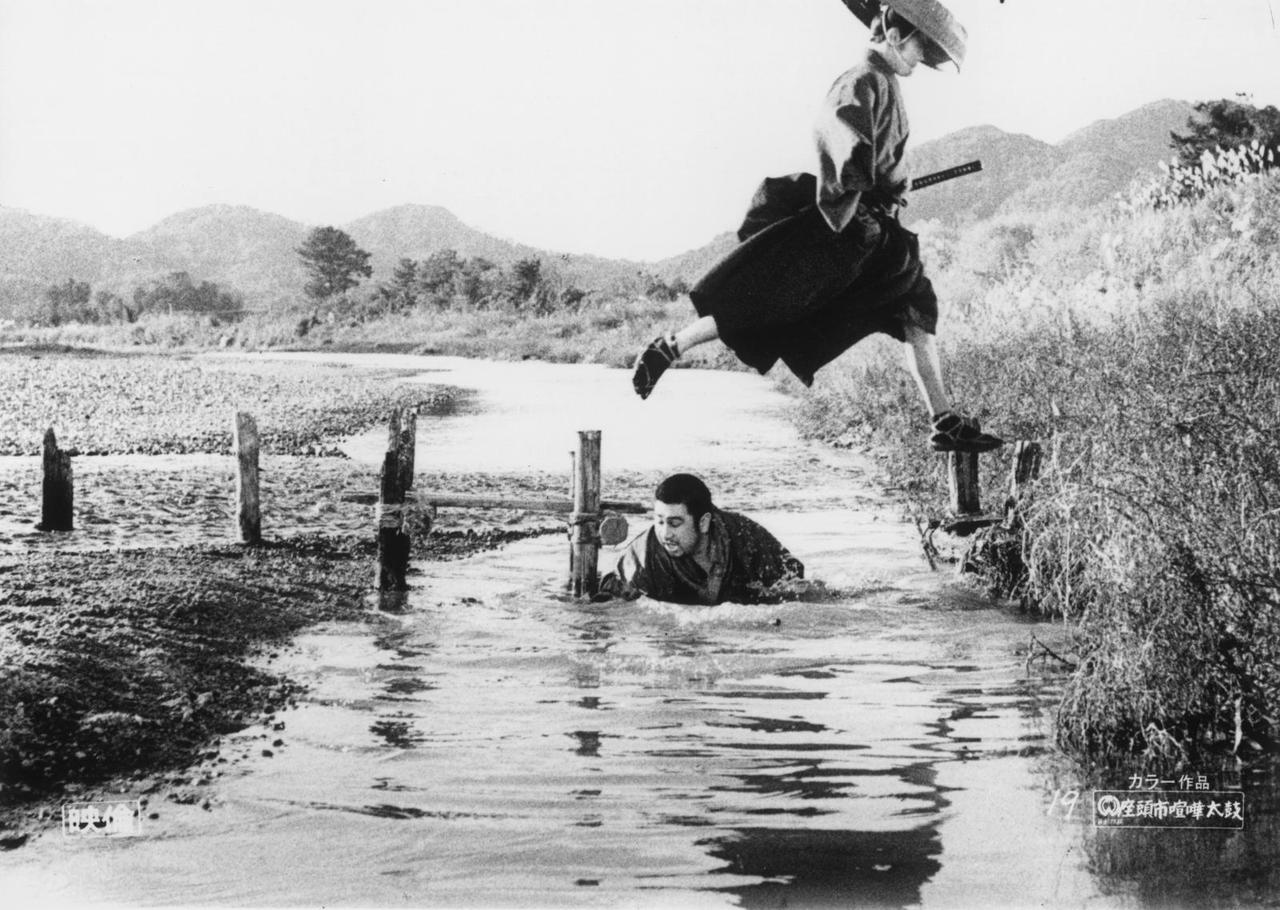
Zatoichi – The Scintillating Sword-blade Stained with Blood is the Blu-ray Set Of 2013
You know how many damned years and how much of a quest it was for me to finally manage to get a full set of theZatoichi: the Blind Swordsman film series on DVD? I'm sure it was over a decade. Just this year I managed to find the last Zatoichi I was missing, after all that searching and wanting to see complete my collection of the series. And what happens? A week after I finally have all 25 Zatoichi films, Criterion announces they are releasing all of the series on Blu-ray.
Finally, now you won't have to seek Zatoichi out for years to collect all 25 films in the series. Criterion has made it easy for you with the most beautiful Blu-ray set of 2013, with prints better and sharper than the ones I waited years to behold, and packaged elegantly, with all the films placed within a intricately illustrated book-style box that holds the films along with a disc of extras that offers material I did not know even existed after all my diligence in hunting the films down — plus a wonderfully illustrated and written collector's book that details each film. I should also note this set includes the DVD versions of the Zatoichi films as well as the newly remastered Blu-rays.
This is a set made for collectors and fans. This new collection is a beautiful thing for anyone familiar with the series, especially if you have come to know how consistently well-filmed even the weakest Zatoichi entry is.
Whether in black and white, as with the first two films, released by Daiei Studios in 1962, or in color, from 1963 on, there is often a lyricism of tonal shading, of a naturalistic rustic beauty to these films set in Japan's Edo Period — a little later than when Spanish California's Zorro was righting wrongs.
Zorro was fighting in approximately the early 1820s. Zatoichi was fighting in approximately the early 1830s. I did not realize how close in time the two genre heroes were when I was writing the Zorro newspaper strip, — which I did at about the same time frame I was discovering Zatoichi and the Lone Wolf & Cub Japanese film series,.
I find it fascinating to see the differences in the daily lives and culture between the Zatoichi and Zorro, or more accurately, genre stories, but also where they are similar. Equally fascinating is to look at the methods of storytelling done in series from different countries.

A long downshot establishing where all the combatants challenging Zatoichi lie when all was said and done.
The first film, The Tale of Zatoichi, dramatically demonstrates how radically different content can be in each of these films (which for most unacquainted with them but seeing the image of a stern-faced samurai warrior wielding a blade would probably think are primarily about martial arts and slashing swords), yet in contradiction to this it is about 40 minutes into the movie before Shintaro Katsu makes a display of his skill with swords.
Before he does any swordsmanship, Zatoichi wanders into the midst of a territory seething with conflict between rival clans, takes his time showing his dice-gambling abilities, giving massages and playing blind man to the hilt.
When I saw my first Zatoichi film, about the blind, wandering masseur who travels across lovely landscapes, from township to township using a cane to help guide him that also sheaths a shikomi-zue, a lethal sword-blade, I wasn't sure Shintaro Katsu, the actor wasn't really blind.
Shintaro isn't afraid to let himself appear unattractive, to even at times to be the buffoon. There are moments when his eyes will seem to roll up into his head, and the whites of his eyes will strain against his fluttering eyelids, as if somehow, even without pupils showing, he might see if he concentrates hard enough.
Remember that this film was released in 1962. Swordplay is not the predominant motif that it came to be.

A showdown infused with muted grays bleaching color and life from a bloody life-and-death confrontation.
There is a darkness of the human spirit and callousness and sexuality that mainstream American dramas would seldom go near, in the '60s, and seldom even going into '90s. Even today, how many action-oriented film series would begin with the following scenario?
Otane is a server in the place where Zatoichi stays while sizing the warring combatants up. Her brother Tatekichi has been having sex with a young woman that Otane does not want hurt, and tries to convince him to do the right thing when the woman becomes pregnant.
Tatekichi doesn't just not do the right thing, he does a devastatingly horrendous wrong thing: he drowns the young woman in a marshland near the edge of town.
A strong, superior samurai, Miki Hirate, is hired by the clan that wants to destroy the clan where Zatoichi is staying. He has tuberculosis and is coughing up blood.
Sexual threat is in the air around Otane.
Zatoichi is the blind observer who knows everything that has happened, He always knows more than the sighted players about him, who often believe they know everything and are trying to manipulate everyone else.
Zatoichi does not really go into formidable action until the very end. He is derisive of all the people in power, all the corrupt maneuverings. He is dismayed at the brutality toward the young woman killed so ruthlessly. And in the end he must face the one man he finds honorable, but who is dying; the one man he has shared confidences with in discussions about the nature of life and death.
It may not seem as striking a difference in today's storytelling, but in 1962, these films explore dark places blatantly that would not exist in American film series. How many ostensibly action oriented films do you know done in America in 1962 that would have these events within their story-line?
By the second Zatoichi movie, Taei had some idea that the blind samurai wanderer would be a success. In The Tale of Zatoichi Continues Zatoichi moves into action much more quickly than in the first film, dispatching a number of thugs without even breathing heavily.
The last of the black-and-white filmed Zatoichis already showcases the exquisite compositions and lighting that would enhance so many of the subsequent films over the years, with color soon delineating mood and style, some landscapes captured like paintings of depth and essence of place.
The composition of images throughout the Zatoichi series is strikingly beautiful, sometimes haunting, sometimes vibrant, and often meticulous, in style and ev
en arrangement of figures within the image.
The narration often has a bleak gray streak, a sound echo of the visuals. I am going to include one brief section ofZatoichi voice-over, a sequence of pastoral meditation beside water so clear one views not only the ripples in the current but sees to its bottom:
ZATOICHI: It's so quiet here. Miki Hirate, I've never known such a skilled swordsman. We fished here together and drank sake together, too. Truly an admirable samurai. Yet it was I who killed him. Until I felt the sword penetrate his body I never imagined I could kill him. For the sake of meaningless war between Yakuza clans I lost a man it took me forever to find: a man I could call friend. It has been a year since then. And then there's Otane. I wonder what has become of her? She is another I cannot forget. I didn't fully understand when Otane said she wanted to marry me. It took me by surprise. What happened with Ochiyo was a shock, too. After saying she would be my wife, she ran off with the man I despise more than anyone. I thought my whole world had gone dark. Of course, it ought to have gone dark. I was already blind by then.
We see as clearly within Zatoichi as we do into the water he stands beside.
A striking downshot, reds echoing carnage about to come, as Zatoichi is trapped with the visual confines of the shot, the locale and the action.
Don't be deceived by my description. Not all of Zatoichi is dark and grim. Humor abounds in many of the films.
Zatoichi can do a lot of things with great expertise, as heroes often can, but I can't recall many who actually breast-feed a baby as Zatoichi does. The claim is that this can happen and has been done. I'm just reporting the news. I don't suspect we're going to see James Bond breast-feeding an infant in any decade? You know what I mean.
The usage of bridges is extensive in Zatoichi, a passageway from one place to another, underneath a hidden byway. In both places, events can unfold which will change your life, whether you travel above or below.
Normally I would recommend you wait on viewing the extras that come with a set, but here I think you will really gain some insight into Shintaro Katsu, and how different he is from the character he played for so many years. The documentary film reveals a lot of candid moments in Katsu's personal life, and the films are understood better with the documentarian discussing what was filmed. You will have more insight into what is happening within the documentary if you view John Nathan revealing what was happening during that chaotic filming.
Criterion has also included a book that has a page devoted to each film by Geoffrey O'Brien, each film having a painting or illustration by a wide range of artists.
You can check out Criterion's trailer for the Zatoichi films at the end of this article.
I know the images displayed here will move you as much as anything I have written here.
This truly was the most thoughtfully prepared complete Blu-ray film series done in 2013.
Many people who love comics will love Zatoichi. If you haven't experienced him, then I hope some of you now take advantage of the care and preservation and presentation of the character on disc.
Zatoichi has endured, been cherished, for years. And now is the chance for more film lovers to see why.
The sword is sheathed back in the cane.
Copyright © 2013 by Don McGregor
 The Official Website of Don McGregor
The Official Website of Don McGregor


